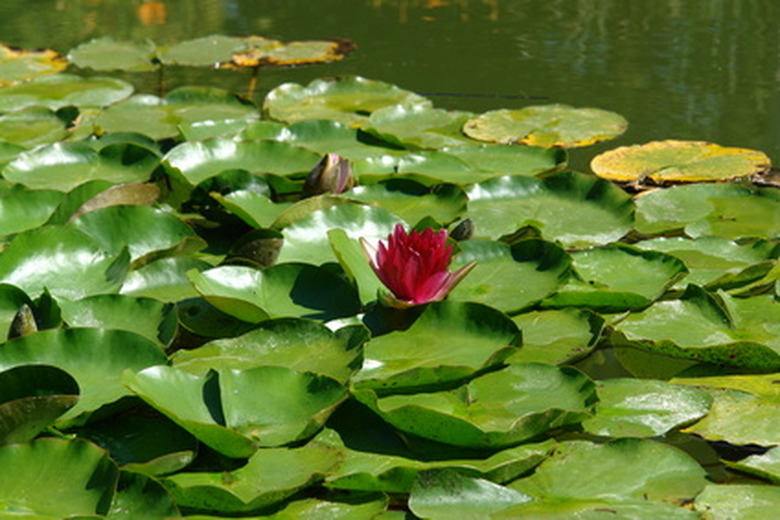How To Propagate Water Lilies From Leaves
Water lilies are some of the most widely recognized and beautiful of pond plants. There are many varieties, and most are propagated by means of rhizomes. However, some varieties produce plantlets, which are tiny plants that grow from the leaves. These plantlets put out their own roots and begin growing when the leaf has died. Plant propagation from leaves and flowers of a plant is called viviparous reproduction, and you can do it in your own pond as long as you have an appropriate variety. Varieties capable of viviparous reproduction include N. lotus, N. micrantha, N. "August Koch," N. "Bagdad," N. "Bluebird," N. "Charles Thomas" and many other day-blooming or hardy cultivars.
Things Needed
- Mature water lilies
- Small knife or scissors
- Large watertight tub (25 to 40 gallons)
- Small rock
- Grow lights (optional)
- Small watertight pot
Water lilies are some of the most widely recognized and beautiful of pond plants. There are many varieties, and most are propagated by means of rhizomes. However, some varieties produce plantlets, which are tiny plants that grow from the leaves. These plantlets put out their own roots and begin growing when the leaf has died. Plant propagation from leaves and flowers of a plant is called viviparous reproduction, and you can do it in your own pond as long as you have an appropriate variety. Varieties capable of viviparous reproduction include N. lotus, N. micrantha, N. "August Koch," N. "Bagdad," N. "Bluebird," N. "Charles Thomas" and many other day-blooming or hardy cultivars.
Step 1
Look for unusual growths on the lily pads. Specifically look for small nodes, which indicate the imminent presence of a plantlet and that it is time to begin propagation. It is not necessary to wait until the plantlet has produced roots or a stem.
- Water lilies are some of the most widely recognized and beautiful of pond plants.
- Plant propagation from leaves and flowers of a plant is called viviparous reproduction, and you can do it in your own pond as long as you have an appropriate variety.
Step 2
Remove with a knife the entire lily pad with the plantlet on it. Removing the leaf when the plantlet is just a node, rather than when the leaf begins to decay (which is the normal method), causes the plantlet to grow more quickly.
Step 3
Fill the large tub with water and place the lily pad into it. Weigh the lily pad down with the rock.
Step 4
Keep the tub in indirect sunlight or use grow lights on it. Mount the grow lights so that they shine directly on the water. Keep the water at room temperature, approximately between 80 and 90 F, to encourage fast growth.
- Remove with a knife the entire lily pad with the plantlet on it.
- Mount the grow lights so that they shine directly on the water.
Step 5
Plant the seedlings in the small watertight pot (as you would a normal lily seedling) when the roots have begun to sprout. Keep 2 to 3 inches of water above the soil and keep it out of direct sunlight, which could damage the young plant. Cover the roots with soil, but not the stem.
Step 6
Move the plant when it has reached a sufficient size for the depth of your pond. The time may be as short as two or three weeks.
